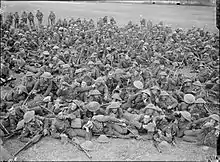72nd Brigade (United Kingdom)
The 72nd Brigade was an infantry brigade formation of the British Army in the First World War and the Second World War.
| 72nd Brigade 72nd Independent Infantry Brigade 72nd Infantry Brigade | |
|---|---|
 Formation sign for the 72nd Independent Infantry Brigade, January 1941 — June 1943.[1] | |
| Active | 1914 — 1919 21 January 1941 — 1 June 1943 28 April 1944— |
| Country | |
| Branch | |
| Type | Infantry Brigade |
| Role | Infantry |
| Insignia | |
| 72nd Brigade battle patches used in the First World War, from August 1916.[2] |  Top (l-r) 8th Queen's (West Surrey), 9th East Surrey, 8th Royal West Kent, 1st N Staffs. Lower 72nd MG Company. |
| Formation sign of the 72nd Indian Infantry Brigade.[3] |  Used with the 29th Brigade's sign to form the 39th Division's sign. |
First World War
Formation and Service
It was raised as part of the new army (Kitchener's Army) and assigned to the 24th Division and served on the Western Front during the First World War.

The brigade was disbanded after the war.
Order of Battle
During the First World War the following units served in the 72nd Brigade.[4]
- 8th (Service) Battalion, Queen's (Royal West Surrey Regiment) (to 17th Brigade in February 1918)
- 8th (Service) Battalion, Buffs (East Kent Regiment) (to 17th Brigade in October 1915)
- 9th (Service) Battalion, East Surrey Regiment
- 8th (Service) Battalion, Queen's Own (Royal West Kent Regiment)
- 1st Battalion, Prince of Wales's (North Staffordshire Regiment) (from 17th Brigade in October 1915)
- 72nd Machine Gun Company
- 72nd Trench Mortar Battery
Second World War
Formation and Service

In January 1941, the 72nd Independent Infantry Brigade was formed. In 1943, the Brigade HQ was re-designated the 5th Parachute Brigade after its units were dispersed.[5] A new 72nd Infantry Brigade was formed on 28 April 1944 from the 72nd Indian Infantry Brigade which was renamed and joined the 36th Infantry Division.[6]
Order of Battle
During the Second World War the following units served in the Brigade.[5]
- As the 72nd Independent Infantry Brigade
- 13th Battalion, Royal Welch Fusiliers (21 January 1941 — 24 September 1942)
- 6th Battalion, Royal Inniskilling Fusiliers (21 January 1941 — 14 January 1942)
- 15th Battalion, South Staffordshire Regiment (21 January 1941 — 25 May 1942)
- 4th Battalion, East Lancashire Regiment (14 January 1942 — 8 October 1942)
- 11th Battalion, Devonshire Regiment (8 October 1941 — 25 May 1943)
- 9th Battalion, Somerset Light Infantry (9 September 1942 — 21 May 1943)
- As the 72nd Infantry Brigade in India
- 6th Battalion, South Wales Borderers (28 April 1944 — 18 July 1945)
- 10th Battalion, Gloucestershire Regiment (28 April 1944 — 31 August 1945)
- 9th Battalion, Royal Sussex Regiment (28 April 1944 — 31 August 1945)
References
- Cole p. 130
- Hibberd p. 24
- Cole p. 87
- "24th Division". The Long Long Trail. Retrieved 20 January 2012.
- Joslen p. 303
- "72nd Indian Infantry Brigade". www.odersofbattle.com. Archived from the original on 7 January 2017. Retrieved 6 January 2017.
Bibliography
- Cole, Howard (1973). Formation Badges of World War 2 Britain, Commonwealth and Empire. London: Arms and Armour Press.
- Hibbard, Mike; Gibbs, Gary (2016). Infantry Divisions, Identification Schemes 1917 (1 ed.). Wokingham: The Military History Society.
- Lt-Col H.F. Joslen, Orders of Battle, United Kingdom and Colonial Formations and Units in the Second World War, 1939–1945, London: HM Stationery Office, 1960/Uckfield: Naval & Military, 2003, ISBN 1843424746.